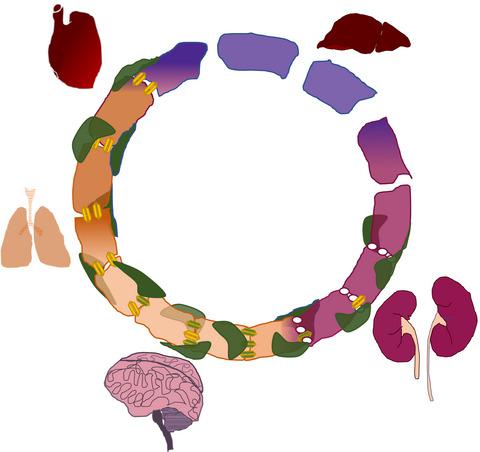Our official English website, www.x-mol.net, welcomes your
feedback! (Note: you will need to create a separate account there.)
Endothelial cells and organ function: applications and implications of understanding unique and reciprocal remodelling.
The FEBS Journal ( IF 5.5 ) Pub Date : 2019-11-17 , DOI: 10.1111/febs.15143 Moritz Reiterer 1, 2 , Cristina M Branco 1
The FEBS Journal ( IF 5.5 ) Pub Date : 2019-11-17 , DOI: 10.1111/febs.15143 Moritz Reiterer 1, 2 , Cristina M Branco 1
Affiliation

|
The microvasculature is a heterogeneous, dynamic and versatile component of the systemic circulation, with a unique ability to locally self-regulate and to respond to organ demand and environmental stimuli. Endothelial cells from different organs display considerable variation, but it is currently unclear to what extent functional properties of organ-specific endothelial cells are intrinsic, acquired and/or reprogrammable. Vascular function is a fundamental pillar of homeostasis, and dysfunction results in systemic consequences for the organism. Additionally, vascular failure can occur downstream of organ disease or environmental stress, often driving an exacerbation of symptoms and pathologies originally independent of the local circulation. The understanding of the molecular mechanisms underlying endothelial physiology and metabolism holds the promise to inform and improve diagnosis, prognosis and treatment options for a myriad of conditions as unrelated as cancer, neurodegeneration or pulmonary hypertension, and likely everything in between, if we consider that also treatments for such conditions are primarily distributed via the bloodstream. However, studying endothelial function has its challenges: the origin, isolation, culture conditions and preconditioning stimuli make this an extremely variable cell type to study and difficult to source. Animal models exist but are neither trivial to generate, nor necessarily adequately translatable to human disease. In this article, we aim to illustrate the breadth of microvascular functions in different environments, highlighting current and pioneering studies that have advanced our insight into the importance of the integrity of this tissue, as well as the limitations posed by its heterogeneity and plasticity.
中文翻译:

内皮细胞和器官功能:了解独特和相互重塑的应用和意义。
微脉管系统是系统循环的异质,动态和通用组件,具有独特的局部自我调节能力以及对器官需求和环境刺激的响应能力。来自不同器官的内皮细胞表现出相当大的变化,但是目前尚不清楚器官特异性内皮细胞的功能特性在多大程度上是固有的,获得的和/或可重编程的。血管功能是体内平衡的基本支柱,功能障碍会导致机体发生全身性后果。另外,血管衰竭可发生在器官疾病或环境压力的下游,通常使原本与局部循环无关的症状和病理恶化。对内皮生理和新陈代谢的分子机制的理解有望为改善与癌症,神经退行性疾病或肺动脉高压无关的多种疾病以及可能介于两者之间的各种疾病提供信息并改善其诊断,预后和治疗选择,如果我们认为这也是这种情况的治疗主要通过血液分配。然而,研究内皮功能有其挑战:起源,分离,培养条件和预处理刺激使其成为极易变化的细胞类型,难以研究。存在动物模型,但既不能琐碎地生成动物模型,也不一定可以对人类疾病进行充分的翻译。在本文中,我们旨在说明不同环境中微血管功能的广度,
更新日期:2020-03-16
中文翻译:

内皮细胞和器官功能:了解独特和相互重塑的应用和意义。
微脉管系统是系统循环的异质,动态和通用组件,具有独特的局部自我调节能力以及对器官需求和环境刺激的响应能力。来自不同器官的内皮细胞表现出相当大的变化,但是目前尚不清楚器官特异性内皮细胞的功能特性在多大程度上是固有的,获得的和/或可重编程的。血管功能是体内平衡的基本支柱,功能障碍会导致机体发生全身性后果。另外,血管衰竭可发生在器官疾病或环境压力的下游,通常使原本与局部循环无关的症状和病理恶化。对内皮生理和新陈代谢的分子机制的理解有望为改善与癌症,神经退行性疾病或肺动脉高压无关的多种疾病以及可能介于两者之间的各种疾病提供信息并改善其诊断,预后和治疗选择,如果我们认为这也是这种情况的治疗主要通过血液分配。然而,研究内皮功能有其挑战:起源,分离,培养条件和预处理刺激使其成为极易变化的细胞类型,难以研究。存在动物模型,但既不能琐碎地生成动物模型,也不一定可以对人类疾病进行充分的翻译。在本文中,我们旨在说明不同环境中微血管功能的广度,









































 京公网安备 11010802027423号
京公网安备 11010802027423号